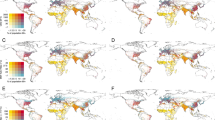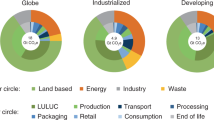Abstract
While it is well known that exercise minute ventilation (VE) results in greater pulmonary function and subjective symptoms (SS) responses upon exposure to a given ozone (O3) dose, the magnitude of VE increase to produce a significant forced expiratory volume in 1 s (FEV1.0) response compared to that observed at a lower exercise VE for the same O3 concentration and exposure time is unclear, especially in prolonged (i.e., >2 h) exposures. Further, in prolonged exposures, the relationship of body size to FEV1.0 response to a given O3 exposure dose has not been systematically examined. In the present study, 30 young adults were exposed on four occasions for 6 h (during a 6.6-h period) to constant O3 levels of zero (filtered air, FA) or 0.12 parts per million (ppm). At the latter concentration, exercise VE was varied in exposures to 17, 20, and 23 l min−1 m−2 of BSA, respectively, for each individual to achieve an equivalent ventilation rate, EVR). In the FA exposure, EVR was 23 l min−1 m2. Percent changes in FEV1.0 for the three 0.12 ppm O3 exposures were significantly greater than that for FA, but did not differ significantly from each other. For the 6.6-h exposures, exercise EVR at or in excess of 17 l min−1 m−2, SS values were significantly greater than those observed for the FA protocol. Further, SS values at 6.6 h of exposure to 0.12 ppm O3 for the exercise EVR of 23 l min−1 m−2 protocol were significantly greater than for the 0.12 ppm O3 exercise EVR of 17 l min−1 m−2 protocol. To achieve a widened EVR, two 1-h exposures to 0.30 ppm O3 with continuous exercise (CE) at a level necessitating an EVR of 17 and ∼34 l min−1 m−2, respectively, were completed by each subject. All postexposure pulmonary function and SS responses were significantly greater for the higher 1-h EVR protocol. In all exposures with significant O3-induced changes in FEV1.0 and SS, it was found that the smaller subjects who exercised at the lowest absolute VE had significantly smaller responses than did the larger subjects. These results strongly suggest that for the O3 concentrations and exposure durations used in this study, the effect of VE on O3-induced FEV1.0 and SS responses is not body-size-dependent.
This is a preview of subscription content, access via your institution
Access options
Subscribe to this journal
Receive 6 print issues and online access
$259.00 per year
only $43.17 per issue
Buy this article
- Purchase on Springer Link
- Instant access to full article PDF
Prices may be subject to local taxes which are calculated during checkout
Similar content being viewed by others
Author information
Authors and Affiliations
Corresponding author
Rights and permissions
About this article
Cite this article
ADAMS, W. Ozone dose–response effects of varied equivalent minute ventilation rates. J Expo Sci Environ Epidemiol 10, 217–226 (2000). https://doi.org/10.1038/sj.jea.7500086
Received:
Accepted:
Published:
Issue Date:
DOI: https://doi.org/10.1038/sj.jea.7500086
Keywords
This article is cited by
-
The Acute Effects of Exercising in Air Pollution: A Systematic Review of Randomized Controlled Trials
Sports Medicine (2022)
-
The Health Effects of Exercising in Air Pollution
Sports Medicine (2014)
-
Should People Be Physically Active Outdoors on Smog Alert Days?
Canadian Journal of Public Health (2005)



